#from the rehearsal room at the savoy
Text
I went to see From The Rehearsal Room at the Savoy and I compiled notes. Keep in mind I wrote this on the tube on the way back from it so it might be a bit crazy but yk…
- Before the show we went on stage to look round and Hadley and Ramin were there to tune their guitars so they performed Hushabye mountain for us and then the group was taking a picture and Hadley snuck in and photobombed
⁃ They wore matching sockssss and it wasn’t even deliberate
⁃ I cant even remember why he brought it up but once Hadley had a bear on the roof of his apartment and they had to tranquillise it
⁃ He also performed once with a racoon staring at him
⁃ Ramin was singing this really beautiful song and Hadley was in the back with his legs crossed and one elbow resting on the piano and he was chugging water as everyone was crying
⁃ They bashed on people who watched I’m A Celebrity which was kind of funny tbh
⁃ Hadley is a Lord Of The Rings girlie which we love. He’s got that deluxe Lord Of The Rings trilogy swag
⁃ RAMIN SANG TIL I HEAR YOU SING AND THE AUDIENCE SCREAMED THE MINUTE THE CHORDS STARTED
⁃ THEY SANG LILY‘S EYES
⁃ HADLEY FORGOT HIS CHARACTER’S NAME (NEVILLE) AND THEY WENT ON FOR AGES TRYING TO NAME THIS CHARACTER AND THEN HADLEY JUST REFERRED TO THE CHARACTER AS NIGEL
⁃ Hearing Hadley talk about the Pirate Queen was very lovely
⁃ They were talking about the Secret Garden and they asked if it was ‘the’ Secret Garden or just ‘Secret Garden’ then they started using different words instead of ‘the’ and then Hadley started speaking in a northern accent and it was oddly good. I know he’s an actor but have you heard him in the Pirate Queen lmao
⁃ I don’t condone shipping irl people but once you see it live you can’t deny it. My mum literally thought they were husbands
⁃ Ramin sang a song and then afterwards Hadley said how the love just CAME OUT of him for Ramin
⁃ They held handsssss
⁃ After the interval Hadley sang Funny from City Of Angels and oh my golly goodness gracious it was absolutely brilliant. It’s one of my favourite songs ever and aaaaaaaaaa it was so good
⁃ Also Hadley got us to do three part harmony and he started speaking French??? It sounded angelic tho it was so beautiful. I love Just Let Go so so much it was so good with 1000 people singing it in beautiful harmony
⁃ Also the way he taught it: my choir teacher could never
⁃ He’s so patient and dad-like
⁃ Well he is a dad
⁃ A dad I’d like to-
⁃ He didn’t win the dilf awards I can’t finish that sentence
⁃ Just a reminder that I was there for the dilf awards 2022
⁃ Also it’s confirmed that Hadley’s mum calls him Robert which I always wondered about bc his name isn’t actually Hadley
⁃ Also right right right
⁃ Sheytoons turned into Gaytoons bc during the line “this time there’s no way of hiding the way you feel” Ramin got really tense and then he was properly reacting to the song but subtly and I don’t think it was deliberate
⁃ Babygirl this time there’s no way of hiding the way you feel for Hadley Fraser
⁃ RAMIN SINGING WHO ID BE
⁃ AND IT WAS SO GOOD
⁃ AND HADLEY SAID “PETITION FOR RAMIN TO BE THE NEXT SHREK” AND BABYGIRL YOURE SO RIGHT
⁃ Empty chairs at empty tables
⁃ Empty chairs at empty tables
⁃ I am not okie dokie
⁃ It was beautiful
⁃ So so beautiful
⁃ And then when they did the iconic harmonies I started sobbing
⁃ It was too much for my brain to handle
⁃ Then they said they couldn’t leave us on a sad note so they did YOULL BE BACK
⁃ I CANNOT EXPRESS HOW FUCKING BRILLIANT YOULL BE BACK WAS
⁃ So it started with Ramin, all bouncy and funky and stuff
⁃ But then oh my golly goodness gracious Hadley
⁃ He OWNED King George III so so hard
⁃ He did a very posh British accent and acted the living hell out of it
⁃ It was the best thing I’ve ever seen
⁃ And then he stuck one of his legs out in sort of a tango way and was very flamboyant and I’ve seen silly Hadley but I’ve never seen truly campy, flamboyant Hadley and it’s the best kind of Hadley
⁃ Then the whole audience did the da da da da das and it was so neat singing with Ramin and Hadley live
⁃ And they were doing a dancey dance and HADLEY AS KING GEORGE III I BEG, THATS ALL I ASK OF YOU, PLEASE ILL ACTUALLY ENJOY HAMILTON IF HADLEY IS KING GEORGE PLEASEEEEEE
⁃ Then it ended and we did a meet and greet and Hadley asked my name and I said it and Ramin and Hadley both shook my hand and then Hadley recognised me (it’s complicated to explain but basically he once saw a picture of me) and went “oh Maddie!!! It’s so good to see you!” Then he hugged me. Robert Hugh ‘Hadley’ Fraser hugged me. He didn’t do that for anyone else. He opened his arms and said “come here” in a nice way not a creepy way den
⁃ Overall such an insane experience, if you thought either of them were good in recording it’s just even better live. I’ve never heard them sing so well.
If any of you were there watching it please add anything I missed on
#hadley fraser#ramin karimloo#from the rehearsal room#from the rehearsal room at the savoy#sheytoons#ramley
51 notes
·
View notes
Text
SOLD OUT ❤️
[x]
35 notes
·
View notes
Text
Happy New Year!
As a little New Year treat, I though I'd share the finale from the Live From The Rehearsal Room concert at the Savoy! This encapsulates so much of the joy present in the room from the get-go for me, as well as being a fun and bouncy tune.
Also bonus gift under the cut: A complete track list for the concert! Full audio available for trade.
Mastered by @or-what-you-will
Title - Musical/Source (singer)
Act One
Butter Outta Cream – Catch Me If You Can (Hadley and Ramin)
Use What You Got – The Life (Hadley)
If I Could Ever Leave You – Camelot (Ramin)
If I Didn’t Believe in You – The Last 5 Years (Hadley)
Lily’s Eyes – The Secret Garden (Hadley and Ramin)
A Little Bit of Earth – The Secret Garden (Hadley)
It All Fades Away – The Bridges of Madison County (Ramin)
How Glory Goes – Floyd Collins (Hadley)
‘Til I Hear You Sing – Love Never Dies (Ramin)
Dirty Rotten Number – Dirty Rotten Scoundrels (Hadley and Ramin)
Act Two
Losing – Ramin (Hadley and Ramin)
Feed the Birds – Marry Poppins (Ramin)
Just Let Go – Hadley (Hadley and audience!)
Sunset Boulevard – Sunset Boulevard (Ramin)
Double Talk – City of Angels (Hadley)
Funny – City of Angels (Hadley)
Beautiful City – Godspell (Ramin)
Anyone Can Whistle – Anyone Can Whistle (Hadley)
Who I’d Be – Shrek (Ramin)
Empty Chairs at Empty Tables – Les Misérables (Hadley and Ramin)
You’ll Be Back – Hamilton (Hadley and Ramin)
#audio#audio gift#hadley fraser#ramin karimloo#live from the rehearsal room#hamilton musical#you'll be back
38 notes
·
View notes
Text
DAYBREAK
1917
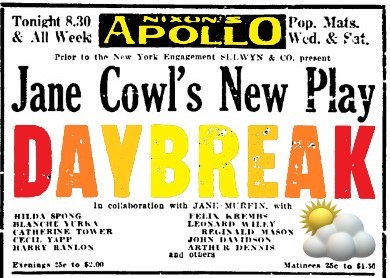
Daybreak is a play by Jane Cowl and Jane Murfin. It was originally produced by Selwyn and Company staged by Wilfred North and Miss Cowl.
Successful businessman Arthur Frome, who drinks too much, pushes a newsboy under an automobile, thus causing him severe injuries. His wife Edith then becomes disillusioned with her husband and leaves him. After an absence of a few years, Edith returns to her husband but offers no explanation of her behavior. Soon, however, Arthur becomes suspicious when she and their family friend, Dr. Brent, frequently visit a house in which a small child is living. Arthur has Edith followed by the wife of one of his employees, whom he has caught stealing, and soon discovers that the child, who is gravely ill, is his own. Edith confesses that she did not want to raise their child under the influence of a drunkard and so left him in someone else's care. Soon after this confession, Arthur is shot by the husband of the woman who has followed Edith because the man suspected his wife of having an affair. Arthur recovers, however, as does the child, and through Dr. Brent's intervention is happily reconciled with Edith, with whom he plans a new life.
About the Title: The play begins at daybreak in a darkened hallway of a New York apartment. Cowl and Murfin were intent on creating the mood of daybreak without resorting to clichés that might result in laughter. They nixed a visit from the milkman and a crowing rooster. They settled on a single shaft of yellow light piercing the darkness of the quiet room. The first scene is played in silence with no dialogue to create the ‘hush’ of early morning.
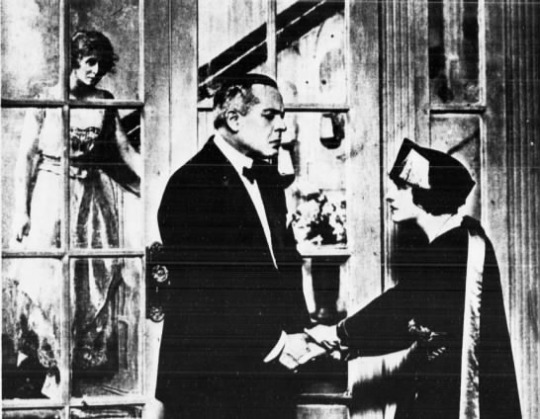
Daybreak premiered in Atlantic City at Nixon’s Apollo Theatre on the Boardwalk on June 18, 1917.
“[The play] was presented to early summer reporters at Atlantic City. It will not, therefore, be an unusual sight in Atlantic City to see a large number of people going home after ‘Daybreak'.” ~ WASHINGTON POST
Edith Frome was played by Blanche Yurka, a performer that Cowl had worked with and promised to help in her career. She was later cast in another play by Cowl and Murfin. Arthur Frome was played by Frederick Truesdell, one of Broadway’s most popular leading men.
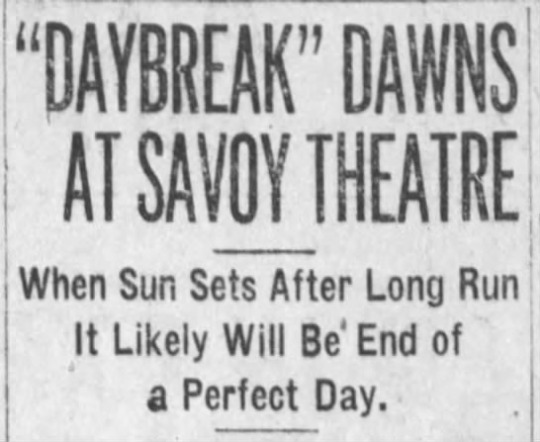
In late July and early August, the play was seen on the Jersey shore in Asbury Park at The Savoy and Long Branch at the Broadway.
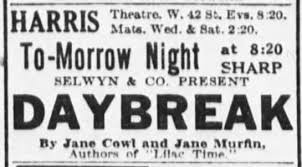
Daybreak opened on Broadway at the Harris Theatre (254 West 42nd Street) on August 14, 1917.
About the Venue: The Harris (named after William B. Harris) was built in 1904 as the Lew Fields Theatre. It was variously known as the Hackett, Wallacks, the Frazee, and finally the Anco Cinema. In 1988, the interior was gutted and it was used as retail space. It was finally demolished in 1997 as part of the 42nd Street redevelopment.

This was the second collaboration between Cowl (above) and Murfin, who previously penned Lilac Time earlier in 1917. Cowl also performed in Lilac Time, which closed on June 9th at The Harris (having transferred from The Republic), allowing Daybreak to move in. Between the two plays, Lilac Time proved the more popular and more successful. In October 1918 they collaborated on a third production, Information Please, with Cowl again performing, which was less successful still. In December 1919, the pair had their most successful script, Smilin’ Through, although they wrote it under the pseudonym Allan Langdon Martin. It inspired two films and two television adaptations. In 1932, Smilin’ Through was the basis for a flop musical titled Through The Years by Vincent Youmans.
"I am really pretty tired," she said. "You see, last summer was a strenuous one. I live at Great Neck on Long Island, and my movie work was done at Fort Lee NJ. I used to get up every morning at 5:30 am and shortly after after 6:30 I was in my car and on my way to Fort Lee. At 7 I was in my dressing room, by 8 I was in the studio. Then it was work until 5 or 6, with a short time off for lunch. Back to New York and rehearsals for "Daybreak,” my new play, until all hours. ~ JANE COWL, OCTOBER 7, 1917
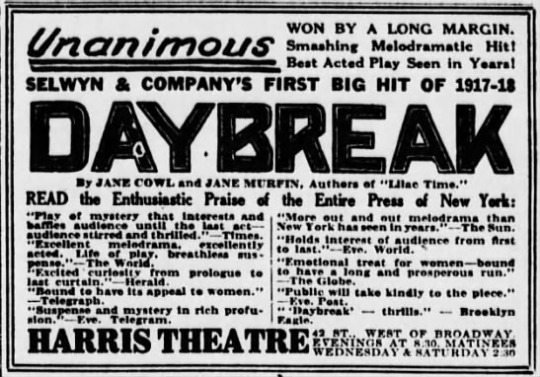
After the play was established on Broadway, Jane Cowl joined the road company of her Lilac Time. As of October 1917, Cowl was also seen on cinema screens in The Spreading Dawn (a title oddly similar to Daybreak), a civil war drama.
Daybreak closed on Broadway on October 13, 1917 after 71 performances.

Daybreak was filmed in 1918 starring Emily Stevens and Julian L’Estrange. It is now considered a lost film.
#Daybreak#Jane Cowl#1917#Jane Murfin#Selwyn & Co#Nixon's Apollo Theatre#Broadway#Broadway Play#Harris Theatre
18 notes
·
View notes
Photo
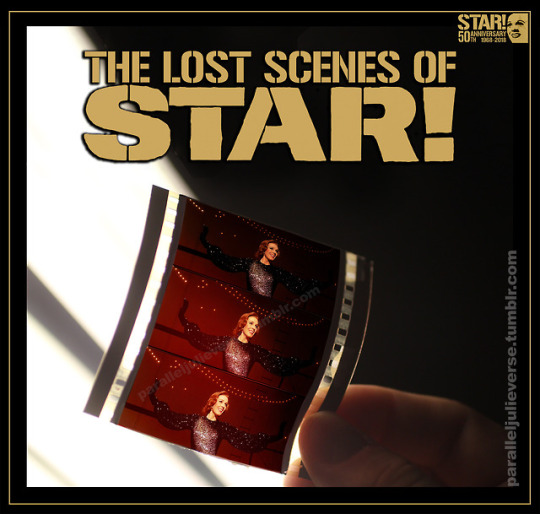
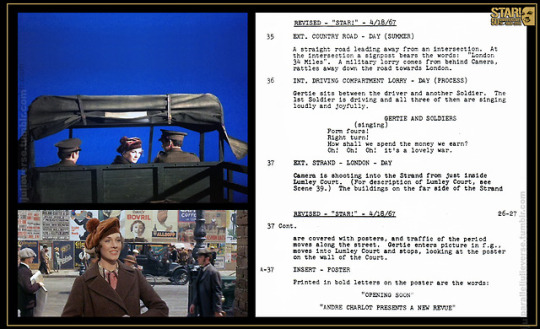


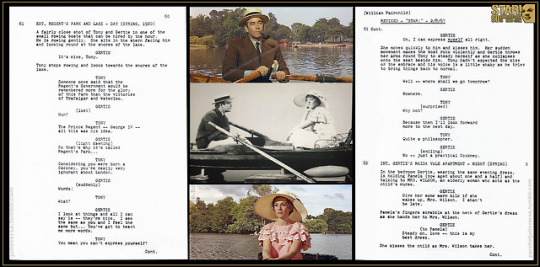
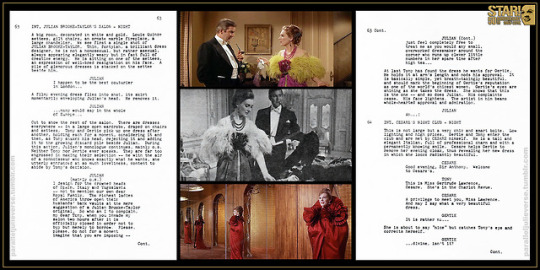
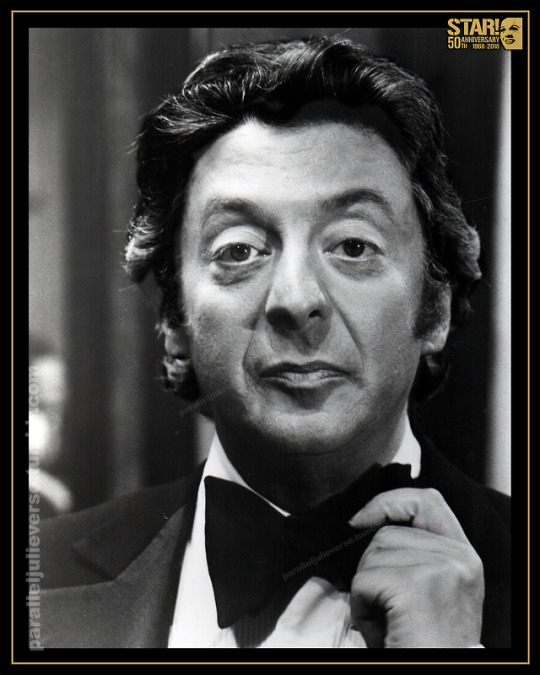



It is common knowledge that Star! –– the spectacular 1968 Julie Andrews musical currently celebrating its 50th anniversary –– underwent substantial editing in the wake of its ill-fated US release. Dismayed by the film’s poor box-office and panicked by the rapid downturn in the domestic movie market, Fox executives ordered a series of increasingly drastic cuts to Star!, culminating in the film’s ignominious withdrawal from distribution in June 1969 and subsequent re-release four months later in a radically shortened, re-titled version as Those Were The Happy Times (formerly known as Star!) (Edwards 1993; Holston: 220-21). This sorry tale of post-release hatcheting is part of the historical legend of Star! and also part of its unjust reputation as “the H-bomb of musicals” (Kanfer: 78).
What is possibly less well-known is that Star! underwent select trimming before its release, as well. At the end of the film’s post-production in April 1968, director Robert Wise had assembled a working rough cut that was shown to studio personnel and test-screened with two preview audiences in Cleveland and Denver in early-May. The response was overwhelmingly positive. Of the 814 preview cards received, 633 rated the film “excellent”, 146 “good” and only 3 marked it “bad” (Edwards). Nevertheless, Wise and editor, William Reynolds, went back to make a number of further adjustments to the film ahead of its global premiere in London in July 1968. Much of this late-stage editing work was relatively minor –– pruning a shot here and there in order to tighten pacing –– but several short narrative scenes were also cut in their entirety.
None of this material was particularly significant and, given that the final roadshow release of Star! ended up with a marathon running time of 176 minutes –– enough to “test the patience of even those of us enamored with Andrews, musicals, and showbiz dramas” (Betancourt, 2014) –– the cuts were possibly all-to-the-good. Still, it is not difficult to see what these excised scenes were designed to achieve and, in some respects, their loss exacerbated problematic aspects of the film’s narrative complexion.
What follows is a brief catalogue of the major scenes dropped from Star! They are presented in order of where they originally occurred in narrative sequence. For the most part, details are taken from the final shooting version of the screenplay by William Fairchild, dated 25 January 1967, and augmented where possible with archival material.
A further sense of where and how these “lost scenes” functioned narratively is provided by the paperback novelization of Star! by Bob Thomas (1968). As discussed in a previous post, novelizations were a popular feature of film culture in the 1960s and 70s. Because they had to be written well in advance of a film’s release, novelizations were typically adapted from shooting scripts and rough cuts and, as with Bob Thomas’s adaptation of Star!, they frequently include narrative material that didn’t always make the final cut.
______________________________
Lost Scene 1: Gertie and the Singing Doughboys
Screenplay Scenes 35-36, 38
(filmed 19 September 1967, Stage 22, 20th Century-Fox Studios)
This short sequence occurred immediately after Gertie makes her stagedoor flight from the disastrous Daffodil Girls music-hall performance in Swansea (“In My Garden of Joy”). In it, Gertie is shown hitching a ride with a military supplies lorry back to London in search of better opportunities. An establishing external shot (35) shows the lorry rumbling down a country road past a “London 34 miles” signpost, followed by an internal shot (36) of the driver’s cabin with Gertie sandwiched between two young soldiers in uniform, all singing a lively chorus of “Oh, It’s a Lovely War” (Fairchild: 25; Thomas: 26).
In earlier versions of the screenplay, this short sequence was preceded by a number of additional scenes (33-34) showing Gertie working odd jobs and sleeping in a train station but these were dropped prior to production and never filmed. A further shot (38) that was filmed but subsequently cut during postproduction occurred in the ensuing scene where Gertie arrives in London and sneaks her way into the Lumley Court Theatre in the hope of auditioning for André Charlot. As she stops in the theatre alleyway, Gertie looks up at the poster advertising the new Charlot revue and whispers to herself “quietly but with complete confidence, ’…With Gertrude Lawrence!’” (Fairchild: 28).
While minor, this cut material clearly worked to underscore Gertie’s driving ambition and her determination to do whatever it takes to realise her dreams of stardom.
______________________________
Lost Scene 2: Gertie and Billie Carleton
Screenplay Scene 53
(filmed 29 April 1967, Stage 14, 20th Century-Fox Studios)
This scene followed Gertie’s triumphant ‘understudy’ performance of “Burlington Bertie”. After the narrational newsreel footage detailing Armistice Day celebrations and the return of star Billie Carleton to the theatre, Billie is seen backstage surrounded by well-wishers from the troupe. Gertie appears from one of the dressing rooms and comes up to greet Billie with ‘star’ and ‘understudy’ indulging in affectionately bitchy repartee. Played with camp theatricality and lashings of “dahhhlings” and air kisses, the scene highlighted Gertie’s growing sense of hauteur and theatrical confidence, while emphasising her thwarted ambitions. It thus helped preface the later confrontation scene (55) between Gertie and first husband, Jack Roper where he complains, “ever since you’ve been put back in the chorus, it’s been nothing but belly-aching!” (Fairchild: 52).
Interestingly, this sequence between Gertie and Billie was the only sustained dialogue scene to feature Lynley Laurence, the actress who plays Billie Carleton in Star!. With its excision, Laurence’s role was reduced to a handful of mostly non-speaking scenes, though she would still receive a special featured screen credit in the final film.
As another interesting aside, the dialogue for the cut scene has Billie Carleton joke that Gertie likely wishes “I’d broken my neck”. The real-life Carleton did in fact die not long after the events depicted here. Following a gala ball at the Albert Hall to celebrate Armistice on 27 November 1918, Carleton returned to her suite at the Savoy Hotel where she was found dead the next day from a cocaine overdose. It was a huge scandal at the time that subsequently formed the basis for Noël Coward’s first hit play, The Vortex (1924) about drug abuse and sexual impropriety in English high society (Hoare: 37-39).
______________________________
Lost Scene 3: Gertie and Sir Anthony Go Boating
Screenplay Scene 61
(filmed 29 June, Regent’s Park, London; and 23-24 August 1967, Stage 21, and 8 September, Stage 22, 20th Century-Fox Studios)
This was the first of several cut scenes detailing Gertie’s blossoming romance with Sir Anthony ‘Tony’ Spencer (Michael Craig) and, with it, her rise in social status. Immediately following their first dinner date where Gertie alternately titillates and shocks the assembled society guests with ribald theatre stories, Gertie and Tony go on a ‘date’ to the boating lake at Regent’s Park (Fairchild: 60-61). As the pair sit in the rowboat, Tony explains the history of the Park in florid detail as Gertie looks glum and distracted. “Words!”, she says dejectedly, “I look at things and all I can say is –– they’re nice!…You’ve got to teach me more words”, thus highlighting her recognition of the need for increased social sophistication. After a further exchange, Gertie moves in to give Tony a kiss when the rocking of the boat throws her into his arms.
The allusion in this scene to linguistic training sets up a marked Pygamalion / My Fair Lady dynamic with Tony cast as a Professor Higgins-type figure –– albeit, more “patient and kind and wonderful” –– who helps mentor Gertie in the ways of aristocratic high society. There is even a pointed reference in the dialogue to Gertie’s background as a Cockney. Traces of this dynamic remain in the final film, notably in the scene where Gertie arrives at Cesare’s in her new gown and, responding to a compliment about the dress, starts to say “It is rather nice…” when she catches Tony’s eye and quickly corrects herself, “…er…divine, isn’t it?” (Fairchild: 64).
This scene on the lake involved considerable strategic planning during filming. At the end of a one week period of location shooting in the south of France in June 1967, the production crew proceeded to London for the next stage of filming. Julie, however, flew back to Hollywood, ostensibly to start rehearsals for the big musical numbers, though there is some suggestion she needed to avoid entering the UK for tax purposes (Craig: 151; Land: 296). As a result, location shots on the lake at Regent’s Park had to be filmed using a double to stand in for Julie who sat in the boat with actor Michael Craig. London’s notoriously capricious weather added to the woes with the crew having to wait hours on the day of shooting till 5:00pm when “the sun burst forth long enough to permit the photographing of a brilliant scene”. All the while, “property master, Dennis Parrish, had to toss bread to ducks…to keep them within camera range ready when the time came” (Land: 334-35; also Heffernan: 30). This location footage was then intercut with later process shots of Julie and Michael Craig filmed in front of a blue-screen at Fox studios. Production accounts detail that studio filming for the scene occupied two full days on August 23 and 24 on Stage 21 (Edwards). Despite the work and effort, the dialogue component of the sequence was cut in its entirety and all that remained in the final release print is a few brief insert shots of Gertie and Tony in the rowboat.
______________________________
Lost Scene 4: Gertie Gets a Make-Over
Screenplay Scene 63
(filmed 11-13 and 18 September 1967, Stage 16, 20th Century-Fox Studios)
Continuing the Pygmalion theme from the previous cut scene, this sequence detailed Gertie’s ongoing social metamorphosis as Tony takes her to the salon of couturier, Julian Brooke-Taylor (Fairchild: 63-64). Of all the cut scenes, this one was possibly the longest with an estimated running time of several minutes.
Here Gertie is introduced to the grand world of haute couture and the even grander character of Julian Brooke-Taylor. Described in the screenplay as “[t]hin, fortyish…not a homosexual, but rather asexual, always appearing elegantly weary but in fact full of creative energy” (Fairchild: 63), Brooke-Taylor was played by Scottish-born character actor, Monty (Monte) Landis. Today, Landis is best remembered for his cavalcade of cameo villains in the cult TV series The Monkees (1968) but he had a long career as a comic actor in theatre and film in both the UK and the US. Prior to Star!, Landis had a string of minor but memorable character cameos in films such as The Mouse That Roared (1959), Charade (1963) and Double Trouble (1967), as well as several popular TV series of the era including The Girl from U.N.C.L.E. (1966), Get Smart (1967) and Batman (1967). The latter series was filmed at 20th Century Fox studios at more or less the same time as Star! which is possibly how Landis secured his brief role in the film.
As detailed in the Fairchild screenplay (63-64) and Thomas novelization (50-51), the lengthy sequence starts with a mid-shot of Brooke-Taylor sitting on a Louis Quinze settee, “an expression of well-bred resignation on his face” (Fairchild: 63). As he spouts a humorously imperious monologue about being “the best couturier in London..many would say the whole of Europe”, the film cuts to a long shot of Gertie and Tony combing through hundreds of glamorous gowns in the gilt and marble salon, “dresses are everywhere –– in a large open wardrobe, draped on chairs and settees” (Fairchild: 63). Gertie picks up dress after dress, “considering it and then, as Tony shakes his head, rejecting it and adding it to the growing discard pile beside Julian” (ibid). All the while, Brooke-Taylor continues his waspish spiel:
“So who am I to complain, my dear Tony, when you invade my salon two hours after it is officially closed in order not to buy but merely to borrow. Please, please, do not for a moment imagine that you are imposing –– just feel completely free to treat me as you would any small, overworked dressmaker around the corner who runs up clever little numbers in her spare time after high tea…” (Fairchild: 63-64).
Finally, Tony finds the perfect dress –– the brilliant black and ruby beaded décolleté gown that Gertie wears to Cesare’s in the next scene. As he holds it up to Gertie, Brooke-Taylor stops mid-breath, “[h]is face lightens, [t]he artist in him beams whole-hearted approval and admiration,” “Ah!,” he purrs, “Yes!” (Fairchild: 64; Thomas: 51).
Other than highlighting Gertie’s continued social transformation, this scene also served to establish the context for Gertie’s subsequent employment as a salon model for Brooke-Taylor in the later fashion show sequence. Its omission from the final print of the film doesn’t cause a major logical inconsistency but it does weaken some of the backstory. From the way it is written, and given Landis’s theatrical comic style, one imagines that the scene would likely have had a ‘comic relief’ tenor not unlike that of the later fashion show where Cathleen Cordell provides such wonderfully humorous flourish as the affected salon vendeuse.
It’s unclear why the Brooke-Taylor sequence was dropped in its entirety. Production accounts show that more than two full days were spent shooting material for it from 11-13 September 1967 on Stage 16 at Fox Studios, with the fashion show filmed immediately after on the same set from 13-14 September (Edwards). Further retakes were ordered for 18 September which possibly suggests that Wise was unhappy with aspects of the scene as originally filmed/played. Maybe he remained unhappy, maybe the sequence felt out of keeping with surrounding material, or maybe Wise just wanted to reduce an already overlong first half? Either way, the visit to Julian Brooke-Taylor was consigned to the cutting room floor.
Monte Landis, the actor playing Brooke-Taylor, had a bit of an unfortunate run in 1967. At about the same time he filmed his dropped cameo for Star!, Landis also appeared as part of the original line-up for the TV pilot of Rowan and Martin’s Laugh-In, but when the series was subsequently picked up by NBC for what would prove to be a six season run, Landis was let go and replaced by another British comedian (Erickson:108). There was some compensation for the actor when he secured his semi-recurring role as the resident villain in the second season of The Monkees (1968), which as suggested earlier remains his most famous work to this day. As detailed in his iMDB profile, Landis continued to secure intermittent TV work throughout the 70s with cameos in shows such as Hawaii Five-O (1971), Columbo (1971) and Police Woman (1973), as well as the odd big screen film like Myra Breckinridge (1970) and Young Frankenstein (1974). As late as the 80s and early 90s, Landis could still be seen popping up in the occasional episode of The Golden Girls (1987) or comedy film like Pee-wee’s Big Adventure (1985) and Heart Condition (1990).
In between these screen assignments, Landis seems to have done a good deal of live theatre. In an interesting “six degrees” moment, just a few months prior to his work on Star!, Landis appeared in a revival of Lady in the Dark at the Pasadena Playhouse –––– opposite Marni Nixon in the Gertrude Lawrence role, what’s more –– where he reportedly stopped the show with the comic “Tchaikovsky” number (“Monty Landis Draws”: 35). Landis also found something of a second career as a spiritualist in the 1970s hosting a weekly programme on a Southern California radio station devoted to the occult (Martin: S8). This interest in all things spiritual must have continued as the last press mention we’ve been able to find about Landis reports that, in 2007, he had retired to Palm Springs where he was teaching Kabbalah (Salkin: E1).
______________________________
Lost Scene 5: Gertie at St James Palace
Screenplay Scene 69
(filmed 29 May 1967, Lotos Club, New York City; and 1 July 1967, Westminster School, London )
This brief scene was the third of the excised episodes depicting Gertie’s social metamorphosis courtesy of Sir Anthony Spencer. Immediately following the newsreel insert profiling Gertie’s embrace of “the fads and the fashions of crazy postwar England of the early 20′s” –– doing the Charleston, hot air ballooning, awarding the prize at an auto car race –– and her ascent to royal social circles, this scene showed Gertie and Tony arriving at St James Palace. Resplendent in a fur-trimmed gold brocade cape, Gertie enters the Palace on the arm of Sir Tony looking every inch the princess when, falling back into mock Cockney, she whispers: “D’you think his Royal Highness would mind if I loosened me stays? They’re killing me” (Fairchild: 71).
The scene was clearly designed to highlight Gertie’s triumph in her new “role” as “the glittering darling of society” while remaining true to her irreverent working-class spirit. This theme –– along with the whole Pygmalion-esque subtext –– is explicit in Bob Thomas’s novelization:
“Under Tony’s tutelage, the girl from Clapham was becoming a lady. The metamorphosis was not always easy. Sometimes in the middle of a formal dinner Gertie uttered a cockneyism that sent the table into a roar of laughter. But she always laughed with the other guests –– Gertie never pretended to be anything she wasn’t. And she always listened carefully to Tony’s coaching afterward. He would point out where she said the wrong thing or used the wrong fork. As in the theatre, she learned her cues quickly and never repeated an error” (Thomas: 56).
Like the earlier rowboat scene, this one required a strategic blend of location and studio shooting. The bulk of the interior was filmed with Julie and Michael Craig on 29 May 1967 at the Lotos Club in New York City. Craig was still appearing on Broadway at the time in Pinter’s The Homecoming and this shoot was his very first piece of work for Star!. Additional footage of Gertie and Tony arriving at St James was filmed a few weeks later on 1 July at the Westminster School in London with Craig and a double to stand in for Julie (Edwards).
______________________________
Lost Scene 6: Cavalry to the Rescue
Screenplay Scene 86-88
(filmed 3 July 1967, Guards’ Parade, Whitehall, London)
This bridging sequence occurred when Sir Anthony Spencer arrives to visit Gertie with his surprise proposal of marriage. Following a series of establishing shots of Tony riding with the Guards on ceremonial parade –– shots which remain in the final release print of the film –– the original sequence continued to show Tony arriving at Gertie’s London mews house. He dismounts from his horse and passes the bridle to his personal equerry, Corporal of Horse Cooper (Max Faulkner). As he walks towards the rear of the house, still in full regalia “his accoutrements clanking”, Tony passes Gertie’s maid Mary (Barbara Ogilvie) who is carrying a tray of tea and sugar to the guardsmen. The camera stays on Mary as she goes to the guardsmen and chats amicably with Cooper, telling him to feed sugar to the horses “[t]hen you can have your tea” (Fairchild: 82).
Other than the opportunity to further showcase the colourful pomp of the Royal Life Guards –– which, as detailed in an earlier post, had been strategically selected by Wise for the visual impact of their uniforms –– this scene also helped underscore the established intimacy of Gertie and Tony’s relationship. That Gertie’s maid should greet Sir Tony and his Corporal by name and come out prepared with a tray of tea for the brigade indicates that this not-so clandestine morning visit to Gertie via her back door was a routine arrangement for the two lovers.
The actor who appears as Corporal Cooper, Max Faulkner had a long career as a character player and stuntman in British film and TV, possibly best remembered for his work on the cult TV show, Doctor Who. The cutting of the sequence meant that Faulkner lost what little dialogue he had in the film, though he can still be seen riding alongside Michael Craig in the opening shot and reacting to Tony’s sneeze. He can also be seen later in the film in reprise footage of the Life Guards on parade, immediately prior to Gertie and Tony’s visit to the Lord Chamberlain. In this scene, which was filmed on location at the same time as the earlier sequence, Faulkner’s character is front and centre on screen bellowing a series of commands to the mounted Guardsmen. In the original screenplay this establishing shot is followed by an additional brief dialogue scene where Gertie passes the Guards on her way into the Lord Chamberlain’s office and greets Cooper by name (Scene 118). “Good morning Miss Lawrence. Nice to see you back,” the corporal says (Fairchild: 123). When Noel shoots Gertie a questioning look, she explains, “Well, I have been to St James Palace before.” “For heaven’s sake,” gasps Noel, “don’t mention that!” (Fairchild: 123).
While Max Faulkner at least made it into the final release print of Star!, Barbara Ogilvie in the part of Mary was less fortunate. With the excision of the dialogue portion of Sir Tony’s arrival at Gertie’s house, her role disappeared completely. A native Londoner, Ogilvie carved out a solid career playing character parts on UK TV, including a regular stint in the mid-70s on the long-running soap opera, Emmerdale. Possibly due to production logistics or possibly to help denote the passage of time, Gertie is given a different maid later in the film, Dorothy who is played by Matilda Canan.
______________________________
As stated at the outset, it is not difficult to understand why these various scenes were cut from Star! Their excision reduced an already over-long running time and arguably helped tighten pacing. Nevertheless, one can equally appreciate the intent behind these scenes and their role in furthering character and plot.
One of the most common criticisms made of Star! is that its episodic revue format works against optimal narrative development and, with it, audience identification. Squeezed into brief segments between the film’s mammoth musical performances, Gertie’s life is rendered via a series of epigrammatic highlights with a surfeit of information and dazzle, but not a lot of emotional depth. As Richard Schickel (1968) writes in a characteristic example of this critical complaint:
“William Fairchild’s Star! script, ranging over a [long] period of Gertrude Lawrence’s career, deals in types rather than people, romances rather than loves. It is always at a documentary distance from its subject and her world. Maybe she was unknowable, in the full biographical sense, but we must have the illusion of knowledge, a sense of motives more subtle and complex than we receive” (10).
Moreover, the fact that Star! is a theatrical revue style musical where the numbers are staged as semi-realist replications of Gertie’s theatrical performances, and not as organic expressions of character and narrative as is the case in an integrated ‘book’ musical, means that whatever sense we get of Gertie and her story can only really come from the bridging moments in-between. As director Robert Wise reflected in later years:
“People often ask me why [Star!] didn’t work…It’s hard to find answers. Maybe [audiences] just weren’t prepared to like Julie in the kind of character Gertie Lawrence was. Maybe we spent too much time on musical numbers and didn’t spend enough time digging into her character, getting the kind of contact of the audience with what made her tick. With The Sound of Music, we certainly made contact with the audience in terms of the relationship between Maria and the children and the Captain. The audience knew where everybody was coming from basically” (Leeman, 195).
It’s doubtful that the excised material profiled here would have made much of an appreciable difference in this regard. Like applying a band-aid to a gaping wound, the film’s narrative deficiencies required more substantial revisions than the inclusion of a couple of minor book scenes. Still, these scenes do at least gesture towards expanded character development and suggest several lines that might have been profitably mined in a more carefully structured narrative treatment.
Finally, it is not known if any of this edited material from Star! still exists. If it does, the chance of it seeing light of day is sadly remote. Cut footage from the Fox-Wise-Andrews megahit, The Sound of Music has never surfaced, suggesting a studio history of either outright junking or public embargo. Moreover, if the material were available, it would surely have been included as part of the comprehensively packaged laserdisc release that accompanied the film’s 25th anniversary in 1993. Still, hope springs eternal and maybe the ‘lost scenes of Star!’ will finally appear as part of that deluxe 50th Anniversary Blu-Ray release that we know just has to be round the corner!
Sources:
Betancourt, Manuel. “Robert Wise Centenary: Star! (1968).” The Film Experience. <http://thefilmexperience.net/blog/2014/9/9/robert-wise-centenary-star-1968.html>. 2014.
Craig, Michael. The Smallest Giant: An Actor’s Life. Sydney: Allen and Unwin, 2005.
Edwards, T.J. “The Saga of ‘Star!’”. Star! Special Edition LaserDisc. Beverley Hills, CA: Twentieth Century Fox Home Entertainment, 1993.
Erickson, Hal. ‘From Beautiful Downtown Burbank’: A Critical History of Rowan and Martin’s Laugh-In. Jefferson, NC: McFarland and Co, 2000.
Fairchild, William. Star! Screenplay. Final version. 25 January, 1967.
Heffernan, Harold. “Squeaky Sound Stage Troubles ‘Star’.” Philadelphia Daily News. 18 August 1967: 30.
Hoare, Philip. Oscar Wilde’s Last Stand: Decadence, Conspiracy, and the Most Outrageous Trial of the Century. New York: Arcade Publishing, 1997.
Holston, Kim R. Movie Roadshows: A History and Filmography of Reserved-Seat Limited Showing, 1911-1973. Jefferson, NC: McFarland and Co, 2013.
Kanfer, Stefan. “Cinema: Quarter Chance.” Time. 96: 4. 27 July 1970: 78.
Land, Kevin. “Recreating Four Decades of Modern History for Star!”. American Cinematographer. 50: 3, March 1969: 294-266, 332-336.
Leeman, Sergio. Robert Wise on His Films: From Editing Room to Director’s Chair. Los Angeles: Silman-James Press, 1995.
Martin, Bob. “TeleVues: They Have the Spirit, It Says.” Independent Press-Telegram. 5 August 1973: S8.
“Monty Landis Draws Many Laughs in ‘Lady’”. Independent Star News. 15 January 1967: 35.
Salkin, Judith. “Building One’s Character.” The Desert Sun. 18 November 2007: E1.
Schickel, Richard. “Two Stars: One Glowing One Dim.” Life. 65: 19. 8 November 1968: 19.
Thomas, Bob. Star! New York: Bantam, 1968.
Images:
“70 mm cinema film strip” by Zigmej, CC BY-SA 3.0 [Adapted].
STAR!, 1968 [Laserdisc], R. Wise, Fox Video, 1993.
St Hilaire, Al. Photographic Contact Sheets for STAR! [Unpublished], 1967.
Twentieth Century Fox, STAR! Press Kit and Publicity Materials, 1968.
Special thanks to Hanne.
Copyright © Brett Farmer 2018
#julie andrews#Star!#star!50#Robert Wise#gertrude lawrence#classic film#musical#lost scenes#film history#old hollywood#lynley laurence#monte landis#Twentieth Century Fox#William Fairchild#michael craig#max faulkner#barbara ogilvie
20 notes
·
View notes
Text
50 Years Ago: 1969 in Rock Music | Best Classic Bands
50 Years Ago: 1969 in Rock Music
Share This:
What is the first thing that comes to mind when you think back to the music of 1969? Perhaps it’s Woodstock, the rock festival that still defines the very concept of the rock festival. Or maybe it’s one of the year’s many great albums—if you’re like us, you still listen to Tommy, Volunteers, The Band, Blind Faith, Led Zeppelin II and amazing debuts rom Santana and Crosby, Stills & Nash, as well as many others that were born in 1969.
Rock was still very exciting as the ’60s came to a close, with bands and artists from both America and across the Atlantic turning out some of their most memorable work. Talk about prolific: Creedence Clearwater Revival, a band that had just made its name known the year before, landed no less than three albums in the top 10 in 1969: Bayou Country, the #1 Green River and Willy and the Poor Boys. The Stones were on a roll, following up the previous year’s brilliant Beggars Banquet with the equally superb Let it Bleed—while saying goodbye to one member and adding a new one. The Beatles were beginning to wind down, but we didn’t know that at the time—when they released Abbey Road, we just took it for granted that they were once again evolving.
Although there was a whole new rock sound, a more mature, progressive approach that found its home on FM radio and in the ballrooms sprouting up around the country, AM radio hitmakers were also still grabbing our ears (and our wallets)—a look at the hit singles of the year reveals numerous gems by artists that never quite made that leap to hipville but whose contributions still find their way to our playlists.
We went back in time 50 years and compiled a chronological timeline of the year’s top events (including album releases) in rock music. Then we listed the bands that formed during that year, and those that called it quits.
Finally, we compiled a list of the year’s top singles. Looking at it all now, we have to admit that we were all very lucky to have this music in our lives—and we still are!
1969 Music Timeline
Jan. 5—Creedence Clearwater Revival releases Bayou Country
Jan. 12—The self-titled debut album by Led Zeppelin is released
Jan. 13—The Beatles release the soundtrack for Yellow Submarine
Jan. 17—Dr. John releases Babylon, Iron Butterfly releases Ball, Aretha Franklin releases Soul ’69
Jan. 22—Neil Young releases his self-titled debut album
Jan. 30—The Beatles give their final public performance on the rooftop of the Apple building in London; on the same date, Moby Grape releases Moby Grape ’69
Jan. ?—Tommy James and the Shondells release Crimson & Clover, Donovan releases Greatest Hits, Fleetwood Mac releases English Rose, and Fairport Convention releases What We Did on Our Holidays
Watch Tommy James & the Shondell’s perform “Crimson & Clover”
Jan. ?—Three of the Beatles—John, George and Ringo—hire Allen Klein as their new manager; Paul does not sign on with the American
Feb. ?—Paul McCartney hires the law firm of the father of his girlfriend, Linda Eastman, to represent him
Feb. 5—Cream releases Goodbye
Listen to “Badge” from Cream’s Goodbye
Feb. 10—The Beach Boys release 20/20
Feb. 15—The Monkees release Instant Replay
Feb. 17—Bob Dylan and Johnny Cash record together in Nashville; the Temptations release Cloud Nine
Feb. 18—British singer Lulu and Maurice Gibb of the Bee Gees are married
Feb. 21—Mary Hopkin releases Postcard
Feb. 22—Ten Years After releases Stonedhenge
Feb. ?—Jefferson Airplane releases Bless its Pointed Little Head, the Flying Burrito Brothers release The Gilded Palace of Sin, MC5 releases Kick Out the Jams
March 1—Jim Morrison of the Doors is arrested for allegedly exposing himself onstage in Miami
March 5—The Byrds release Dr. Byrds & Mr. Hyde
March 7—Genesis releases From Genesis to Revelation
March 12—Paul McCartney and Linda Eastman are married in London; on the same day, George Harrison and his wife Pattie are arrested for possession of hashish
March 14—Free releases Tons of Sobs
March 17—The Rascals release Freedom Suite
March 20—John Lennon and Yoko Ono are married in Gibraltar; several days later, during their honeymoon in Amsterdam, they stage a multi-day “bed-in” for peace
March 24—The Mothers of Invention release Mothermania
March 30—The Bee Gees release Odessa
March 31—Dusty Springfield releases Dusty in Memphis
Listen to “Son of a Preacher Man”
March ?—Steppenwolf releases At Your Birthday Party, 13th Floor Elevators release Bull of the Woods, Blue Cheer releases New! Improved!, James Brown releases Say It Loud (I’m Black and I’m Proud), Spooky Tooth releases Spooky Two, the Velvet Underground releases their self-titled album, the Guess Who releases Wheatfield Soul
April 1—The Beach Boys sue Capitol Records for unpaid royalties; on the same date, Nazz releases Nazz Nazz, and Leonard Cohen releases Songs From a Room
April 9—Bob Dylan releases Nashville Skyline
Watch Bob Dylan sing “I Threw It All Away” on The Johnny Cash Show
April 15—Al Green releases Green is Blues
April 20—At a free rock festival in Venice, Calif., audience members riot and more than 100 are arrested
April 21—The Mothers of Invention release Uncle Meat
April 22—The Who performs their rock opera Tommy in full for the first time, in the U.K.
Joe Cocker at Woodstock
April 23—Joe Cocker releases With a Little Help From My Friends
April 30—Marvin Gaye releases M.P.G.
April ?—The London cast recording of Hair is released, Bob Seger System releases Ramblin’ Gamblin’ Man, Savoy Brown releases Blue Matter, Townes Van Zandt releases Our Mother the Mountain
May 1—Joni Mitchell releases Clouds
May 3—Sly and the Family Stone release their album Stand!; also on this date, Jimi Hendrix is arrested for heroin possession in Toronto
May 9—George Harrison releases Electronic Sound, John Lennon and Yoko Ono release Unfinished Music No. 2: Life With the Lions
Members of the Turtles hang at the White House with Tricia Nixon
May 10—The Turtles perform at the White House at the request of President Nixon’s daughter, Tricia
May 12—Muddy Waters releases After the Rain
May 14—Neil Young and Crazy Horse release Everybody Knows This is Nowhere
May 16—Phil Ochs releases Rehearsals for Retirement, Tyrannosaurus Rex releases Unicorn
May 19—Poco releases Pickin’ Up the Pieces
May 23—The Who releases Tommy
May 26—Diana Ross and the Supremes release Let the Sunshine In
May 29—Crosby, Stills and Nash release their self-titled debut album
June 2—John and Yoko stage another bed-in, this time in Montreal; they record “Give Peace a Chance” live there
June 4—Johnny Cash releases At San Quentin
June 6—Elton John releases Empty Sky
June 7—Blind Faith—featuring Eric Clapton, Steve Winwood and Ginger Baker, with bassist Ric Grech—performs for free in Hyde Park
June 11—Three Dog Night releases Suitable for Framing
June 13—Guitarist Mick Taylor joins the Rolling Stones; Pink Floyd releases More
June 16—Steve Miller Band releases Brave New World, Captain Beefheart releases Trout Mask Replica
June 20—The Grateful Dead releases Aoxomoxoa
June 21—Deep Purple releases their self-titled album
June 29—Bassist Noel Redding leaves the Jimi Hendrix Experience
June ?—The Jeff Beck Group releases Beck-Ola, Elvis Presley releases From Elvis in Memphis, Johnny Winter and Lee Michaels release self-titled albums, Alice Cooper releases Pretties for You, Procol Harum releases A Salty Dog
July 3—Rolling Stones co-founder Brian Jones is found dead in the swimming pool at his home in Sussex, England; Fairport Convention releases Unhalfbricking
July 4—The two-day Atlanta International Pop Festival begins in Georgia
July 5—The Rolling Stones perform a free concert in Hyde Park in London, both to pay tribute to Jones and introduce Taylor; Cass Elliot releases Bubblegum, Lemonade, and…Something for Mama
July 10—Tim Buckley releases Happy Sad
July 14—The Film Easy Rider is released, featuring music by the Byrds, Jimi Hendrix Experience, Steppenwolf and others
July 19—The Doors release The Soft Parade
Columbia Records had quite the artist roster, as seen in this 1969 industry ad
July 25—Yes releases Yes
July 29—The Byrds’ Preflyte is released
July 31—Elvis Presley makes his first live concert appearance in years, in Las Vegas; the residency lasts through August
July ?—Moby Grape releases Truly Fine Citizen, Country Joe and the Fish release Here We Go Again, Leslie West releases Mountain, Delaney and Bonnie release The Original Delaney & Bonnie & Friends
Aug. 1—The Atlantic City Pop Festival begins in New Jersey, through the 3rd; also on this date, Jethro Tull releases Stand Up and the Bonzo Dog Doo-Dah Band releases Tadpoles
Aug. 5—The Stooges release their self-titled debut
Listen to “Atlantis” from Barabajagal
Aug. 15—The Woodstock Music and Arts Fair begins in Bethel, N.Y., drawing an estimated 400,000; it ends on the morning of the 18th
Watch: Richie Havens opens Woodstock
Aug. 29—Stevie Wonder releases My Cherie Amour and Jack Bruce releases Songs for a Tailor
Aug. 30—The Isle of Wight Festival is held in the U.K., featuring Bob Dylan, the Band, the Who and many others
Aug. ?—Humble Pie releases As Safe As Yesterday Is, Blind Faith releases their self-titled (and only) album, Boz Scaggs releases his self-titled album, Love releases Four Sail, Muddy Waters releases Fathers and Sons, Harry Nilsson releases Harry, Grand Funk Railroad releases On Time, Santana releases their self-titled debut and Ten Years After releases Ssssh
Sept. 1—Nick Drake releases Five Leaves Left
Sept. 11—Janis Joplin releases her first solo album, I Got Dem Ol’ Kozmic Blues Again Mama!
Sept. 13—John Lennon and the Plastic Ono Band perform at the Toronto Rock and Roll Revival, also featuring Chuck Berry, Little Richard, Jerry Lee Lewis and others
Sept. 19—Fleetwood Mac’s Then Play On is released
Sept. 22—The Band releases their self-titled second album. Read our Album Rewind review here.
Sept. 23—Isaac Hayes releases Hot Buttered Soul, the Temptations release Puzzle People, Diana Ross and the Supremes release Together
Sept. 24—Deep Purple performs at the Royal Albert Hall in London with the Royal Philharmonic Orchestra; Laura Nyro’s New York Tendaberry is released
Sept. 26—The Beatles release Abbey Road
Sept. ?—The Guess Who releases Canned Wheat, the Nice releases The Nice, the Flamin’ Groovies release Supersnazz, the Bob Seger System releases Noah, Savoy Brown releases A Step Further
Oct. 1—The Monkees release The Monkees Present
Oct. 9—The Carpenters release Ticket to Ride
Oct. 10—The Kinks release Arthur (Or the Decline and Fall of the British Empire), Frank Zappa releases Hot Rats, King Crimson releases In the Court of the Crimson King
Oct. 14—Diana Ross and the Supremes release their final single, “Someday We’ll Be Together,” which becomes the last #1 hit of the ’60s; Elvis Presley releases Elvis in Person at the International Hotel, Las Vegas, Nevada
Oct. 16—Three Dog Night releases Captured Live at the Forum
Oct. 20—John Lennon and Yoko Ono release Wedding Album
Oct. 22—Led Zeppelin releases their second album, simply titled Led Zeppelin II
Oct. 27—Johnny Winter releases Second Winter
Watch Johnny Winter at Woodstock
Oct. ?—Pentangle releases Basket of Light, Spirit releases Clear, Free releases their self-titled album, the Turtles release Turtle Soup, Tom Jones releases Live in Las Vegas
Nov. 1—Elvis Presley hits #1 for the first time in seven years, with “Suspicious Minds”
Watch the King perform the hit in 1970
Nov. 2—Creedence Clearwater Revival releases their third album of the year, Willy and the Poor Boys
Nov. 4—The Allman Brothers Band releases their self-titled album, David Bowie releases his self-titled album
Nov. 10—The Byrds release The Ballad of Easy Rider, the Grateful Dead release Live/Dead
Nov. 21—The Moody Blues release To Our Children’s Children’s Children
Nov. 24—Tim Buckley releases Blue Afternoon
Nov. ?—The Hollies release Hollies Sing Hollies, the Bonzo Dog Band releases Keynsham, Joe Cocker releases his self-titled album, Manfred Mann Chapter Three and Mott the Hoople also release self-titled albums, Steppenwolf releases Monster, Rod Stewart releases The Rod Stewart Album, Humble Pie releases Town and Country, Jefferson Airplane releases Volunteers, the Steve Miller Band releases Your Saving Grace
Dec. 5—The Rolling Stones release Let It Bleed. Read our Album Rewind review here.
Watch a 2003 live version of the title track from Let It Bleed
Dec. 6—The ill-fated free concert at California’s Altamont Speedway, starring the Rolling Stones and others, leads to a murder and other violent acts; on the same day, the Jackson 5 release their debut album, Diana Ross Presents the Jackson 5
Dec. 12—The Plastic Ono Band (with John and Yoko) releases Live Peace in Toronto 1969
Dec. 29—Grand Funk Railroad releases Grand Funk
More 1969 albums, release dates unknown:
Mike Bloomfield—It’s Not Killing Me
The Climax Blues Band—The Climax Blues Band
The Fugs—The Belle of Avenue A
The Good Rats—The Good Rats
Norman Greenbaum—Spirit in the Sky
The Hollies—The Hollies Sing Dylan
Howlin’ Wolf—The Howlin’ Wolf Album
Isley Brothers—Live at Yankee Stadium
Jackie Lomax—Is This What You Want
Watch John Mayall live in 1969
Pacific Gas & Electric—Pacific Gas & Electric
Peanut Butter Conspiracy—For Children of All Ages
Rare Earth—Get Ready
Jerry Jeff Walker—Driftin’ Way of Life
The Youngbloods—Elephant Mountain
Warren Zevon—Wanted Dead or Alive
Bands that formed in 1969 (alphabetically)
The Allman Brothers Band, April Wine, Atomic Rooster, Badfinger, Brinsley Schwarz, Brownsville Station, the Carpenters, Crazy Horse, Curved Air, Eggs Over Easy, Faces, Fanny, Focus, Hall and Oates, Hawkwind, Head East, Hot Chocolate, Humble Pie, Judas Priest, Juicy Lucy, Kraftwerk, Lighthouse, Little Feat, Mountain, Mungo Jerry, Nektar, New Riders of the Purple Sage, New Seekers, Osibisa, Pink Fairies, Plastic Ono Band, Popol Vuh, Redbone, Renaissance, the Residents, Seals and Crofts, Sha Na Na, Steel Mill, Steeleye Span, Stone the Crows, Supertramp, Thin Lizzy, Thunderclap Newman, Toe Fat, Tucky Buzard, War, Tony Williams Lifetime, Wishbone Ash, ZZ Top
Bands that broke up in 1969 (alphabetically)
The Action, Amen Corner, American Breed, Ars Nova, Beacon Street Union, Beau Brummels, Eric Burdon and the Animals, Dick and Dee Dee, Dillard and Clark, Dino, Desi and Billy, the Easybeats, Frumious Bandersnatch, H.P. Lovecraft, the Jeff Beck Group, the Left Banke, the Lemon Pipers, the Lovin’ Spoonful, Manfred Mann, the Merry-Go-Round, the Mojo Men, the Music Machine, the Paupers, Spanky and Our Gang, the Spencer Davis Group, Ultimate Spinach
And finally, a selection of the year’s hit singles (alphabetically by artist)…
The Archies—“Sugar Sugar”
The Beach Boys—“I Can Hear Music,” “Break Away”
The Beatles—“Get Back,” “The Ballad of John and Yoko,” “Something”/“Come Together”
The Bee Gees—“I Started a Joke”
Blood, Sweat and Tears—“Spinning Wheel,” “You’ve Made Me So Very Happy”
Booker T. and the MG’s—“Time is Tight,” “Hang ’Em High”
David Bowie—“Space Oddity”
Watch the video for the rare early version of “Space Oddity”
The Box Tops—“Soul Deep”
The Brooklyn Bridge—“Worst That Could Happen”
James Brown—“Mother Popcorn, Pt. 1”
Jerry Butler—“Only the Strong Survive”
Glen Campbell—“Galveston”
Johnny Cash—“A Boy Named Sue”
Checkmates Ltd.—“Black Pearl”
Lou Christie—“I’m Gonna Make You Love Me”
Classics IV—“Traces”
The Cowsills—“Hair”
Crazy Elephant—“Gimme Gimme Good Lovin’”
Cream—“Badge”
Creedence Clearwater Revival—“Bad Moon Rising,” “Proud Mary,” “Green River”
Crosby, Stills and Nash—“Suite: Judy Blue Eyes”
The Cuff Links—“Tracy”
Sammy Davis Jr.—“I’ve Gotta Be Me”
Tyrone Davis—“Can I Change Your Mind”
Desmond Dekker and the Aces—“Israelites”
Jackie DeShannon—“Put a Little Love in Your Heart”
Neil Diamond—“Sweet Caroline”
Bob Dylan—“Lay Lady Lay”
The 5th Dimension—“Aquarius/Let the Sunshine In,” “Wedding Bell Blues,” “Workin’ on a Groovy Thing”
Fleetwood Mac—“Oh Well”
The Flying Machine—“Smile a Little Smile for Me”
The Foundations—“Build Me Up Buttercup”
Friends of Distinction—“Grazing in the Grass”
Marvin Gaye—“I Heard It Through the Grapevine,” “Too Busy Thinking About My Baby”
The Grass Roots—“I’d Wait a Million Years”
Edwin Hawkins Singers—“Oh Happy Day”
Jimi Hendrix Experience—“Stone Free”/“If Six Was Nine”
The Hollies—“He Ain’t Heavy, He’s My Brother,” “Sorry Suzanne”
Mary Hopkin—“Goodbye”
The Isley Brothers—“It’s Your Thing”
Jay and the Americans—“This Magic Moment”
Tommy James and the Shondells—“Crimson and Clover,” “Crystal Blue Persuasion,” “Sweet Cherry Wine”
Tom Jones—“I’ll Never Fall in Love Again”
Janis Joplin—“Try (Just a Little Bit Harder)”
Led Zeppelin—“Whole Lotta Love”
Mercy—“Love Can Make You Happy”
The Monkees—“Listen to the Band”
Nilsson—“Everybody’s Talkin’”
Oliver—“Good Morning Starshine,” “Jean”
Peter, Paul and Mary—“Leaving on a Jet Plane”
Elvis Presley—“In the Ghetto,” “Suspicious Minds”
Billy Preston—“That’s the Way God Planned It”
Gary Puckett and the Union Gap—“This Girl is a Woman Now”
Lou Rawls—“Your Good Thing (Is About to End)”
Tommy Roe—“Dizzy”
Kenny Rogers and the First Edition—“Ruby, Don’t Take Your Love to Town”
The Rolling Stones—“Honky Tonk Women”
Diana Ross and the Supremes—“I’m Gonna Make You Love Me,” “I’m Livin’ in Shame,” “Love Child,” “Someday We’ll Be Together”
David Ruffin—“My Whole World Ended (The Moment You Left Me)”
Bob Seger System—“Ramblin’, Gamblin’ Man”
Simon and Garfunkel—“The Boxer”
Frank Sinatra—“My Way”
Sly and the Family Stone—“Everyday People,” “Hot Fun in the Summertime”
Smith—“Baby It’s You”
Joe South—“Games People Play”
Spiral Starecase—“More Today Than Yesterday”
Dusty Springfield—“Son of a Preacher Man”
Edwin Starr—“Twenty-Five Miles”
Ray Stevens—“Gitarzan”
The Temptations—“Cloud Nine,” “I Can’t Get Next to You,” “Runaway Child, Running Wild”
B.J. Thomas—“Hooked on a Feeling,” “Raindrops Keep Fallin’ on My Head”
Three Dog Night—“Easy to Be Hard,” “One”
Thunderclap Newman—“Something in the Air”
The Turtles—“You Showed Me”
The Ventures—“Hawaii Five-O”
Jr. Walker and the All Stars—“What Does it Take (To Win Your Love)”
Dionne Warwick—“This Girl’s In Love With You”
Tony Joe White—“Polk Salad Annie”
The Winstons—“Color Him Father”
Stevie Wonder—“For Once in My Life,” “My Cherie Amour,” “Yester-Me, Yester-You, Yesterday”
Charles Wright and the Watts 103rd Street Rhythm Band—“Do Your Thing”
The Youngbloods—“Get Together”
Zager & Evans—“In the Year 2525 (Exordium & Terminus)”
The Zombies—”Time of the Season”
Sign up for the Best Classic Bands Newsletter
First Name
Last Name
Email
Other Comments
The BCB team brings you the latest Breaking News, Contests, On This Day rock history stories, Classic Videos, retro-Charts and more.
Latest posts by Best Classic Bands Staff (see all)
This content was originally published here.
0 notes
Text
Individual Fieri Reviews Chicago's Famous Customer, The White Royal residence Grill.
Having actually stayed out from the lime-light whilst working on her brand new songs, Cheryl Cole made a gain to the showing off cameras when she attended the Royal prince's Depend on Buy Futures supper at the Savoy Accommodation, final evening. It is also certainly not peculiar to locate that there have to do with 6 to seven after dinner speeches offered these days, and if these are actually all in a brief capillary, as well as interesting as well as/ or even odd, that is certainly not all that awful for the attendees to need to sit through.
A look back through past efficiencies at the dinner could deliver a clue about why Trump chose he was actually far better off spending the night out of the Washington Hilton. Whether you sit and also enjoy the visibility, or even strike a chat with your family members, a loved ones dinner is http://dietandbeauty-portal.info actually a fantastic technique to compile the family every week.
If the Ariel costume is actually stiff to partake, or even the Cinderella little princess outfit is actually hard to stroll in, ensure that these won't hamper the unique supper day. The Dinner Outfit Blue/White Coat attires showcase a quick coat along with 3 switches on either edge, used open along with a dark bow association and also cummerbund (women substitute a neck tab for the head tie).
Giving a dish that matches your motif is just one of the absolute most essential tips for creating a gala dinner prosperous Although a juicy steak may be an encouraging supper food selection, this would not create much feeling served at a sea-loving themed supper.
Plain white porcelain allows your food items to attract attention and you may decide on a wide array from shapes. If you invite your pals to have a supper and a social celebration, this is a perfect meal especially. A remarkable suggestion for an elegant summer season rehearsal supper is a Fantastic Gatsby inspired yard event.
If you are actually trying to determine what to cook for dinner I will present you to some of the best chicken suppers that just so happens to be one of the healthiest. Ron has what he thinks about the greatest Dinner Party website on the web ... as well as he feels stronlgy that lifespan ought to be actually a. mix of celebrations, as well as little, little bit of parties.
In several parts of the world, particularly previous British nests, the dish discusses some link along with the English Christmas supper involving baked meats and pudding from some explanation. By opportunity you finish mixing the cold substances and clean up, that should suffice opportunity for the apples and also pears to cool down.
That was a challenge only to clean the table off so our company can all sit down and enjoy a food. Several of these dishes that steal restaurant foods are actually also customized so they are actually easy and also quick and easy supper dishes, certainly not needing an expert kitchen space. And also obviously, the most ideal aspect of choosing a house maid cleaning service is actually that you do not have to tidy your own self.
Put the higher seat in the cooking area or even at the dinner table to keep your kid comfy. The regulations are actually stringent: BYO (white) tables, office chairs, tablecloths, candlestick, cutlery and also china, connoisseur food items just, and also no beer-- just red or white wine as well as champagne.
This X-mas dinner layer is a wonderful instance of a style celebrating as well as accepting the powerful track, along with a graphic around the plate side much like a time clock being part of the style. Intend on merely a few starters to make certain that your visitors possess room for dinner (unless this is Thanksgiving holiday dinner, where scenario everyone will come considering to eat means too much anyhow!).
An additional fantastic dinner date suggestion is actually visiting a drive-in supper theatre.If you desire to really have a memorable day, go worn relaxed clothing and also deliver throughout your beloved treats, after that cuddle up in the moonshine. Tropical supper dress blue includes dinner dress blue trousers, summer season white colored (brief sleeve) shirt, an appropriate belt, as well as baby medals and bust insignia.
0 notes
Link
With She Loves Me currently running at its home base, Travesties and David Baddiel: My Family Not the Sitcom taking up residence in the West End, and Funny Girl in rehearsals ahead of a major national tour, the Menier Chocolate Factory today announces full casting for their major new revival of Terence Rattigan’s Love in Idleness. Trevor Nunn directs Eve Best (Olivia Brown), Edward Bluemel (Michael Brown), Helen George (Diana Fletcher), Anthony Head (Sir John Fletcher), Vivienne Rochester (Miss Dell) and Helen Sloane (Polton/Celia Wentworth). The production opens on 20th March, with previews from 9th March, and is running until 29th April.
Returning from Canada after a four-year absence during the war, eighteen-year-old Michael is full of youthful ideology and leftist leanings. But he is shocked to find his widowed mother Olivia is now the mistress of cabinet minister Sir John Fletcher, enjoying a comfortable society life. When Michael and John clash, sparks fly and relationships are tested as everyone learns some difficult lessons in love.
This new production sees Nunn return to Rattigan, following the huge success of Flare Path, with another of the playwright’s trio of ‘war plays’, which also includes While the Sun Shines.
Nunn will follow Love and Idleness with Lettice and Lovage opening on 17th May, with previews from 4 May, and completing its run on 8th July.
Terence Rattigan’s (1911– 1977) major works include The Deep Blue Sea, The Browning Version, Separate Tables, French without Tears and The Winslow Boy.
Eve Best is playing Olivia Brown. Her theatre credits in London include Hedda Gabler (Almeida Theatre / Duke of York’s – Olivier Award for Best Actress, Evening Standard Award for Best Actress),
Antony and Cleopatra, Much Ado About Nothing, Macbeth (Shakespeare’s Globe),The Duchess of Malfi, A Moon for the Misbegotten (The Old Vic), As You Like It (RSC/Sheffield Crucible), Le Misanthrope (Chichester Minerva), Mourning Becomes Electra (Critics’ Circle Award for Best Actress), The Coast of Utopia, Three Sisters, The Cherry Orchard and The Heiress (all National Theatre), and ‘Tis Pity She’s a Whore(Young Vic – London Evening Standard Award and Critics’ Circle Award for Best Newcomer). Her theatre work on Broadway includes Harold Pinter’s Old Times and The Homecoming (Tony Award nomination for Best Actress) and A Moon for the Misbegotten (Tony Award nomination for Best Actress, Drama Desk and Outer Critics’ Circle Awards for Best Actress). For television, her work includes Lucky Man, Nurse Jackie, The Honourable Woman, Life in Squares, The Shadow Line, Shackleton and Prime Suspect; and for film, The King’s Speech. She made her directorial debut with Macbeth at Shakespeare’s Globe in 2013. This is her third collaboration with Trevor Nunn following The Cherry Orchard and The Coast of Utopia.
Edward Bluemel plays Michael Brown. His theatre credits include Animal, Longing, Strange Orchestra, The Winter’s Tale (Richard Burton Theatre Company), Mercury Fur (Company of Sirens). His television credits include The Halcyon. His film credits include The Commuter, Access All Areas.
Helen George plays Diana Fletcher. Her theatre includes After Miss Julie (Theatre Royal Bath and UK tour), The Hotel Plays: The Pink Bedroom (Defibrillator Theatre), A Christmas Fair, A Midsummer Night’s Dream (Milton Rooms), By Jeeves (Landor Theatre), The Woman in White (Palace Theatre) and Company. For television, her work includes Call the Midwife, Red Dwarf, Over to Bill, Dark Matters, Hotel Babylon II, Gatecrasher Summer Sound System; and for film, Scar Tissue, The Child, The Three Musketeers, 7Lives.
Anthony Head plays Sir John Fletcher. His theatre includes Ticking (Trafalgar Studios), Six Degrees of Separation (The Old Vic), The Tempest (New Huntington Theatre), Otherwise Engaged (Criterion) Peter Pan, Pirates of Penzance (Savoy Theatre), The Rocky Horror Picture Show (Duke of York’s), Rope (Wyndham’s), Chess (Prince Edward), Yonadab, The Prince of Homburg (National Theatre) and Patriot for Me (Chichester Festival). For television his work include Still Star-Crossed, Guilt, Drunk History, Harmony, Dominion, Galavant, The Selection, Warehouse 13, Dancing on the Edge, Free Agents, Sold, The Invisibles, Sensitive Skin, Dr Who, Persuasion, Hotel Babylon, Rose and Maloney, My Family, Monarch of the Glen, MIT, New Tricks, Little Britain, Reversals, Manchild, Spooks, Buffy the Vampire Slayer and Love in a Cold Climate; and for film, A Street Cat Named Bob, Despite the Falling Snow, Flying Home, Convenience, Percy Jackson: The Sea of Monsters, Ghost Rider – Spirit of Vengeance, The Iron Lady, The Great Ghost Rescue, Repo! The Genetic Opera, Sweeny Todd and The Tourist.
Vivienne Rochester plays Miss Dell. Her theatre work includes The Magna Carta Plays (Salisbury Playhouse), Singing Stones (Arcola Theatre), The Women’s Spring (The Roundhouse), Twelfth Night (Leicester Haymarket, Belgrade Coventry), Tamburlaine (British Council Tour), Hobson’s Choice (Birmingham Rep), Electra (Shaw Theatre), Sir Thomas Moore (Shaw Theatre), Restoration, Macbeth, The Balcony, Kissing the Pope and The Rover (Royal Shakespeare Company), and A Mouthful of Birds (Royal Court, Birmingham Rep). For television Little White Lies, Men of the Month and Window of Vulnerability.
Helen Sloane returns to the Menier Chocolate Factory to play Polton/Celia Wentworth – she previously appeared in A Little Night Music (also West End). Her other theatre credits include London Road, 50th Anniversary Gala, Anything Goes and Love’s Labour’s Lost (National Theatre), Flowers for Mrs Harris, My Fair Lady and Me and My Girl (Crucible Theatre, Sheffield), Two Cities (Salisbury Playhouse), Enter the Guardsman (Donmar Warehouse), Strife, Way Upstream, The Gondoliers and The Waterbabies (Chichester Festival Theatre), To Kill a Mockingbird (Royal Exchange Manchester), and The Sound of Music, Acorn Antiques, Spend Spend Spend, Martin Guerre, Les Miserables and The Woman in Black (West End). For television, her work includes Maigret, Black Mirror, Home Fires, Call the Midwife, Parade’s End, Dancing on the Edge and Home Again; and for film, The Danish Girl, The Tale of Tales, London Road, Mr Turner, The Theory of Everything, Les Miserables, Broken and Season of the Witch.
From 1968 to 1986, Trevor Nunn was the youngest ever Artistic Director of the Royal Shakespeare Company, directing over thirty productions, including most of the Shakespeare canon, as well as Nicholas Nickleby and Les Misérables. From 1997 to 2003, he was Artistic Director of the National Theatre, where his productions included Troilus and Cressida, Oklahoma!, The Merchant of Venice, Summerfolk, My Fair Lady, A Streetcar Named Desire, Anything Goes and Love’s Labour’s Lost. He has directed the world premières of Tom Stoppard’s plays Arcadia, The Coast of Utopia and Rock n Roll; and of Cats, Sunset Boulevard, Starlight Express and Aspects of Love by Andrew Lloyd Webber. Other theatre includes Timon of Athens, Skellig (Young Vic); The Lady From The Sea (Almeida Theatre); Hamlet, Richard II, Inherit the Wind (The Old Vic), A Little Night Music (Menier Chocolate Factory, West End and Broadway), Cyrano de Bergerac, Kiss Me Kate (Chichester Festival Theatre); Heartbreak House, Flare Path, Rosencrantz and Guildenstern Are Dead, The Tempest (Theatre Royal, Haymarket); Scenes from a Marriage (Coventry & St James), All That Fall (Jermyn Street & New York); A Chorus of Disapproval and Relative Values (West End). Work for television includes Antony and Cleopatra, The Comedy of Errors, Macbeth, Three Sisters, Othello, The Merchant of Venice and King Lear, and on film, Hedda, Lady Jane and Twelfth Night.
Designs are by Stephen Brimson-Lewis; with lighting design by Paul Pyant; sound design by Gregory Clarke, and projections by Duncan McLean.
Listings Information
Menier Chocolate Factory
53 Southwark Street, London, SE1 1RU
Terence Rattigan’s LOVE IN IDLENESS
9th March – 29 April
Press night: 20th March
http://ift.tt/2kjMURh LondonTheatre1.com
0 notes
Text
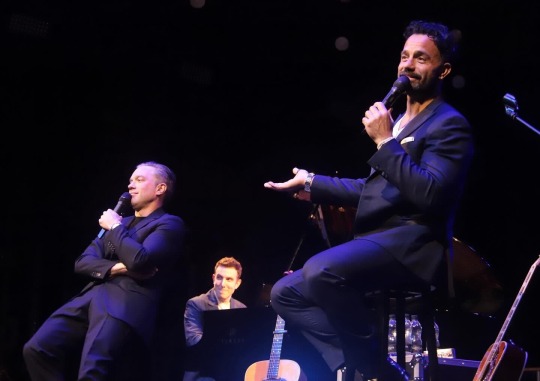

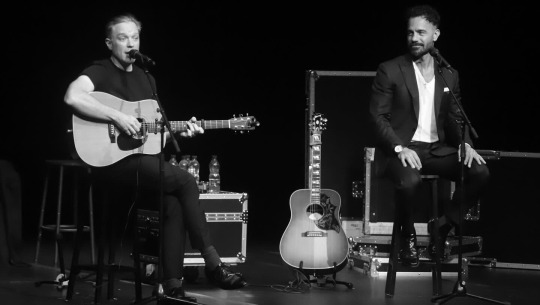

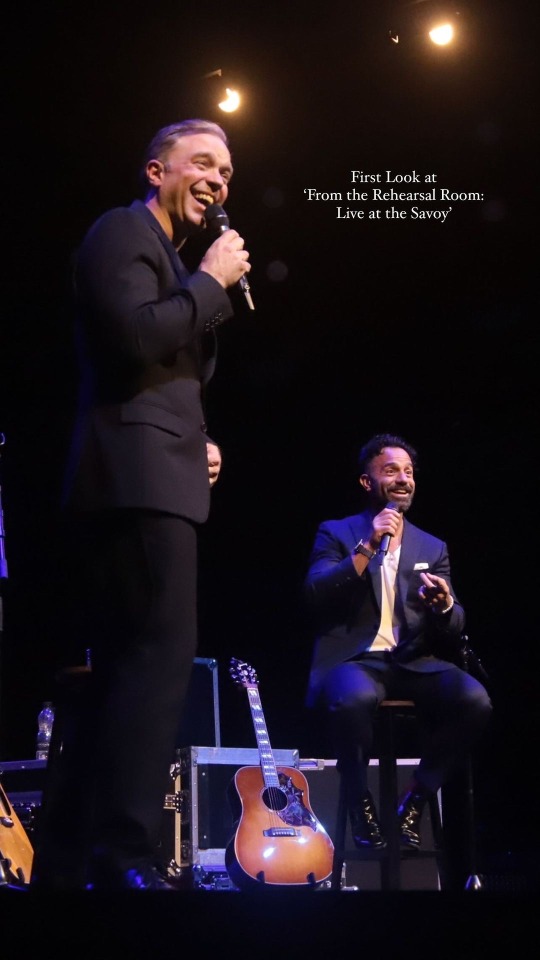
First Look! 'From the Rehearsal Room: Live at the Savoy' with @hadleyfraser and @raminkarimloo alongside @theo.jamieson [x]
36 notes
·
View notes
Text
We (@hadleyfraser @theo.jamieson and I)are less than a week away from bringing 'From The Rehearsal Room' to the iconic @savoytheatreldn | Can not wait. Last few tickets remaining through the link in my bio. Don't miss out. @atg_tickets #london #musical #theatre
#ramin karimloo#hadley fraser#sheytoons#from the rehearsal room : trieste#from the rehearsal room : savoy#instagram
28 notes
·
View notes
Text

TONIGHT - Art done by younger Brother @akarimloo @hadleyfraser @savoytheatreldn #london
24 notes
·
View notes
Text
“You will be here on the day…?”
[x]
29 notes
·
View notes
Text

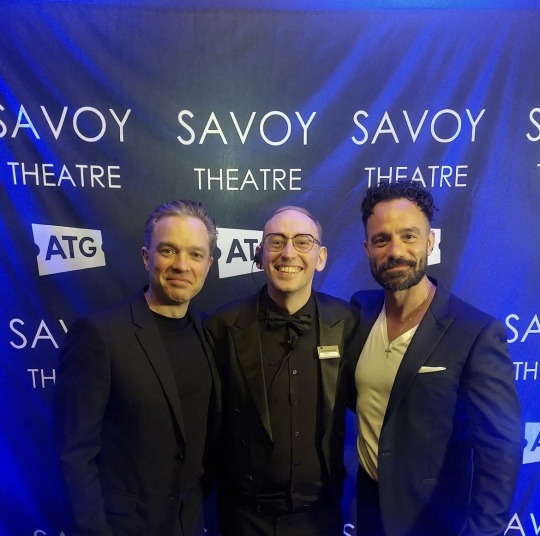
Such fun looking after the brilliant @hadleyfraser & @raminkarimloo in From the Rehearsal Room Live @savoytheatreldn. The crowd went wild 🎭
22 notes
·
View notes
Text

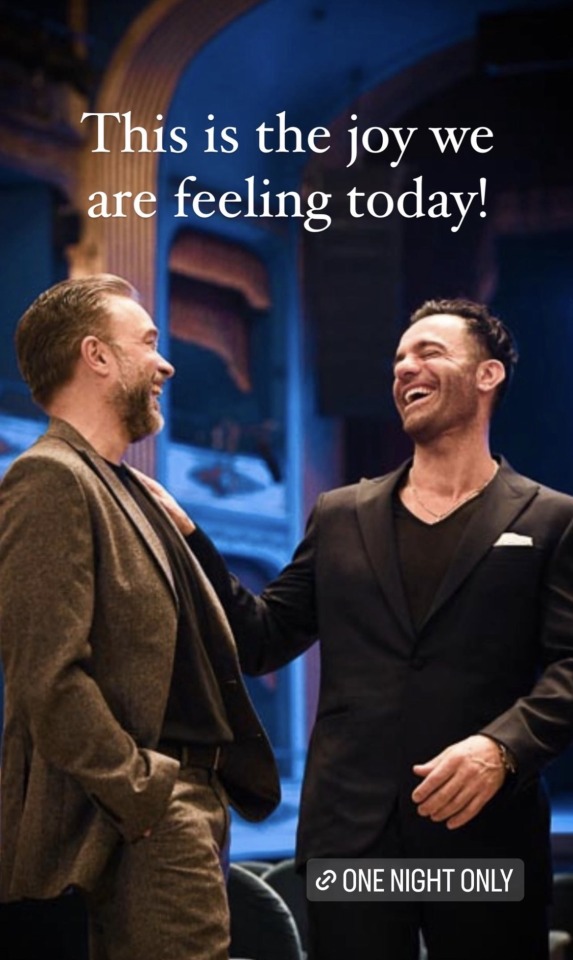
‼️ From the Rehearsal Room : Live at Savoy ‼️
Myself and @hadleyfraser are excited to be partnering up with @savoytheatreldn to bring 'From The Rehearsal Room' for one night only LIVE AT THE SAVOY this November 26 at 7pm. One chance. Sign up here for early ticket sales in the link in the bio. @atg_tickets | Joining us again is the wonderful @theo.jamieson | 📷 Alessandro Pinna @alepinnaphotography
#ramin karimloo#hadley fraser#sheytoons#from the rehearsal room : live at savoy#instagram#instagram stories#link in the source too!
23 notes
·
View notes
Text
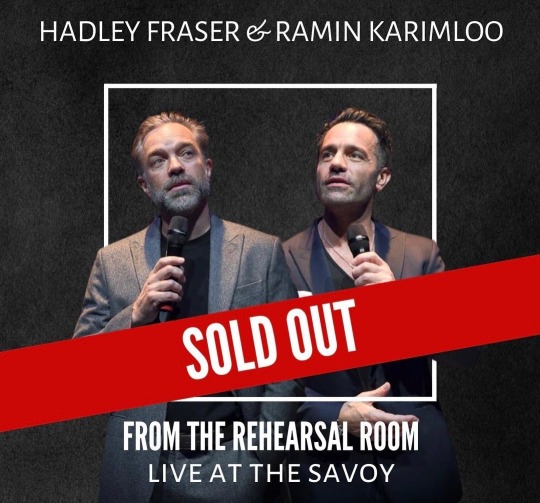
Amazing. Thank you folks. Gonna be fun. @hadleyfraser @theo.jamieson @savoytheatreldn @atg_tickets
#soldout
4 notes
·
View notes
Text
Happy Holidays!
As a little (slightly belated) holiday gift, I thought I'd share a track from Ramin Karimloo and Hadley Fraser's Live From The Rehearsal Room concert in the Savoy Theatre in London on the 26th November 2023.
Full concert available for trade, mastered by @or-what-you-will.
Do not share outside of tumblr.
41 notes
·
View notes